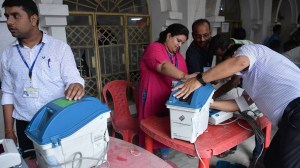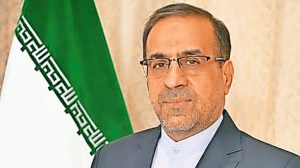- India
- International
Stories on a station wall
From the bright red of Cheriyal scrolls at Secunderabad to the story of the Ram-Sita swayamvar told through Mithila paintings at Madhubani, walls of railway stations across the country are sporting local art.
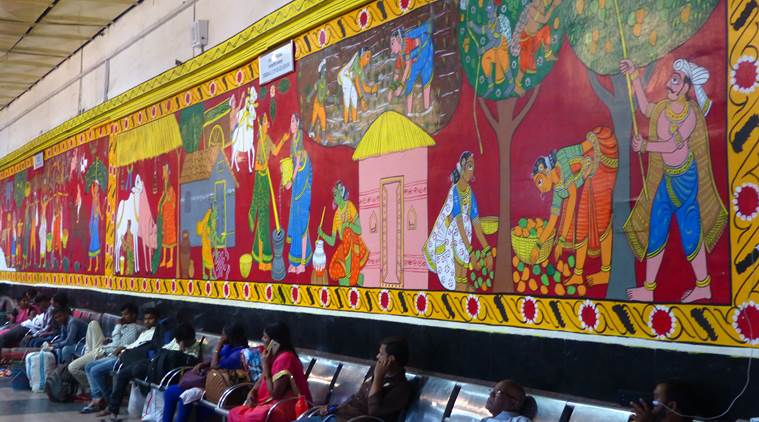 In the waiting hall at Secunderabad is a 50-ft-long mural of Cheriyal art. (Express Photo/Sreenivas Janyala)
In the waiting hall at Secunderabad is a 50-ft-long mural of Cheriyal art. (Express Photo/Sreenivas Janyala)
Sometime in 2015, conservationist and author Valmik Thapar came up with an idea: Why can’t Rajasthan’s Sawai Madhopur railway station look like a place that leads to a tiger habitat of national repute, Ranthambore? Why can’t the Bharatpur station have a look and feel that screams “birds” to millions of tourists who arrive at the station to sight migratory birds at the sanctuary?
Thapar immediately called up then minister of railways Suresh Prabhu — he had known Prabhu while the latter was the Union environment and forests minister.
Prabhu took to the idea. In the weeks that followed, Prabhu marshalled the resources of the Railways, which teamed up with Thapar to look for local tiger painters around Ranthambore National Park.
Enter Narayan Singh and Gajanand Singh, who specialised in painting tigers and other wildlife. For the next eight months, the duo painted the entire Sawai Madhopur station in what was then a unique initiative for the Indian Railways. The toilets, walls, the circulating areas, everything got covered in paintings of tigers, done in the local Ranthambore school of art. Soon, Bharatpur followed suit.
“The idea was to turn railway stations into open-air, public-art museums so that there is greater awareness among people regarding their destinations and what they have as the natural heritage of the country,” says Thapar.

As work began at Bharatpur, it caught the attention of Rajasthan Chief Minister Vasundhara Raje, who came forward to sponsor the work at Bharatpur and other stations such as Jaipur, Kota, Jodhpur and Udaipur, all of which got painted in the traditional Bikaneri style.
Thus, what started as a one-off, local enterprise soon morphed into a pan-India project as the ministry encouraged its 68 divisions across the country to paint their stations.
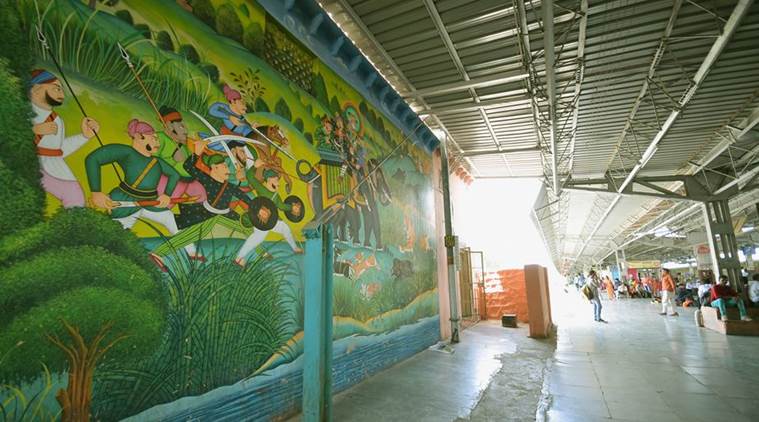 The Indian Railways has just woken up to the possibility of integrating its public spaces with art (Express Photo/Rohit Jain Paras)
The Indian Railways has just woken up to the possibility of integrating its public spaces with art (Express Photo/Rohit Jain Paras)
Today, nearly 100 stations stand covered in largescale paintings in an ever-increasing list while hundreds of other stations sport paintings of some size and scale. To encourage the process, in December 2017, the ministry held a competition of its painted stations. Sixty-two stations from 11 zonal railways participated and were adjudged by a group of two Executive Directors of the ministry, a departmental head from South Central Railway and an official from Northeast Frontier Railway. The results were declared earlier this month. Ballarshah and Chandrapur stations of Central Railway stood first, jointly sharing the prize money of Rs 10 lakh. Bihar’s Madhubani station, which comes under the Railways’ East Central zone, and Madurai of Southern Railway walked away with the second prize and Rs 5 lakh in prize money. West Central Railway’s Kota station, Western Railway’s Gandhidham and South Central Railway’s Secunderabad bagged the third prize and won Rs 3 lakh each.
“Not all stations could qualify because the key criterion was largescale painting with emphasis on local art,” says one of the Executive Directors who was part of the jury.
The Indian Railways has rarely been associated with public art. According to its engineering manual, the colour scheme of a station building is pre-set and defined. There is some leeway for local architecture, but it has to be approved by the zonal General Manager and Divisional Railway Manager (DRM).
For instance, while sprucing up station premises in Delhi as part of the Commonwealth Games in 2010, then Delhi DRM Ashwani Lohani, now Chairman, Railway Board, installed large murals and paintings at the New Delhi railway station.
Eight years later, as Lohani oversees paintings across stations in India, he says the project achieves two purposes. “Apart from being a major step by the Railways to showcase local art forms and culture, the stations also get beautified in the process,” says Lohani.
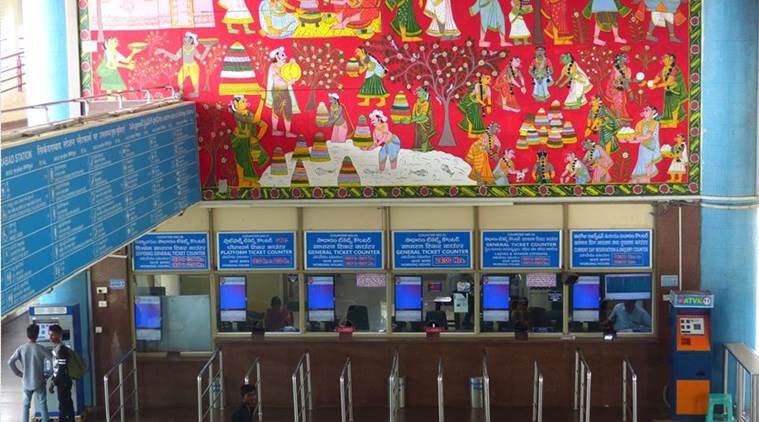 The Railways has encourages its 68 divisions across the country to paint their stations. (Express Photo/Sreenivas Janyala)
The Railways has encourages its 68 divisions across the country to paint their stations. (Express Photo/Sreenivas Janyala)
Globally, public transport and art have come together with greater ease. Several European metro and railway operators have an “art ratio policy”, where 0.5 to 1 per cent of the station’s development budget is fixed for art. Public art was factored into while renewing the Paris Metro, London Underground and the Strasbourg LRT, writes Ewa Maria Kido, renowned Polish architect of urban transport systems, in the Japan Railway and Transport Review, while arguing that public art can play an important role in “improving the image of a railway”.
Though the Indian Railways has just woken up to the possibility of integrating its public spaces with art, the Kolkata Metro, also run by the Railways, did so in the 1980s. Works of famous sculptors such as Alo Dutta adorn its underground stations; patachitra paintings cover the walls of the Kalighat station in South Kolkata, which traditionally had settlements of these artists; and the Rabindra Sadan station has murals of the poet’s manuscripts and so on.
 At some of the stations, however, the paintings, exposed to the elements, have started fading. (Express Photo/Deepak Daware)
At some of the stations, however, the paintings, exposed to the elements, have started fading. (Express Photo/Deepak Daware)
After the start in Rajasthan, the project got a major thrust from the Mumbai suburban network, where 36 stations got painted in October 2016 as part of the Dana Utsav. Somewhere along the way, the initiative got dovetailed with the Centre’s Swachh Bharat Abhiyan. Through all this, the Railways perfected a new model for the job: crowdsourcing.
Two NGOs, Mumbai First and Making a Difference, pooled in 25,000 volunteers and artists from art schools and colleges to paint round the clock for seven days to transform Mumbai suburban stations, while paint companies sponsored the paints as part of their Corporate Social Responsibility.
Today, every DRM dedicates time and resources to spruce up stations through local art. “In some places, artists have volunteered for the job. At other places, we hired tribal art agencies and other groups,” says Mukul S Mathur, DRM, Waltair Division in Visakhapatnam.
The picture, however, isn’t all pretty. At some of the stations, the paintings, exposed to the elements, have started fading. In their defence, officials say theirs is a work in progress and that stations will learn their lessons as they go along.
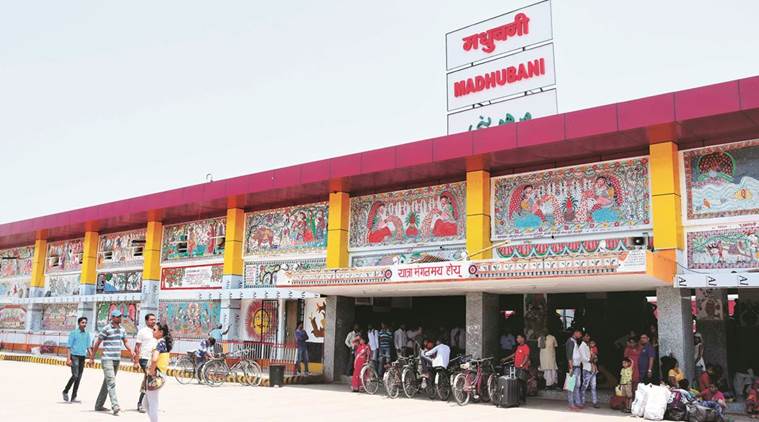 Almost every inch of space at the station has been taken up by these paintings. (Express Photo/Ashok Sinha)
Almost every inch of space at the station has been taken up by these paintings. (Express Photo/Ashok Sinha)
Madhubani, Bihar
The station
Madhubani, which has three platforms dating back to the days of the British, sees a daily footfall of over 5,000 passengers. Two dozen trains start from or pass through the railway station every day.
The art
Almost every inch of space at the station tells a story — of the Ram-Sita swayamvar, Lord Krishna’s exploits, the Ashok Vatika where Ravana is believed to have held Sita hostage, besides scenes from everyday life. To the left of the main entrance is a 50-metre stretch of paintings that depict the journey of a farmer — from living in a thatched hut to moving to a pucca house, owning a bike, tractor and finally a car. To the right of the main gate are more traditional paintings: images of kohvarv (the bridal chamber) and doli kahar (bride in a palanquin), dholiya-bajania (music band). Prohibition is one of the contemporary themes, with a set of paintings ending with a woman thrashing her drunk husband with a broom. While Madhubani paintings are usually done in acrylic and natural colours on paper or cloth, the paintings on the station walls have been done with enamel for lasting effect.
 Today, every DRM dedicates time and resources to spruce up stations through local art. (Express Photo/Vivek Deshpande)
Today, every DRM dedicates time and resources to spruce up stations through local art. (Express Photo/Vivek Deshpande)
The artists
Veena Devi, a Madhubani artist in the town, led a team of 200-odd artists, including her son Vivek, for the mega beautification exercise. When Devi broke the news of Madhubani winning the prize for being one of the country’s most beautiful stations, Vivek, 18, who is hearing and speech impaired, gestured in sign language: “Good. Hopefully, this recognition will improve the condition of Mithila artists.”
The project
Undertaken by the Samastipur division of the Railways as part of the Swachh Bharat Abhiyan, the entire project was wrapped up in 27 days. In August 2017, the station authorities put banners across town, inviting artists to volunteer for the project. In less than a month, over 50 artists applied. Since the exercise was entirely voluntary, the project cost the railways a mere Rs 1 lakh, apart from the cost of paint, brush and other paraphernalia.
“Apart from two free meals, each artist was given Rs 100 a day for food,” says Devi, adding that the NGO Sulabh International gave Rs 2,000 per artist.
Then additional divisional finance manager Gan Nath Jha, who played a key role in mobilising artists, says artists were motivated by the recognition the project would bring them. “Some of them also wrote their mobile numbers on the paintings,” says Jha, now divisional finance manager at Mughalsarai.
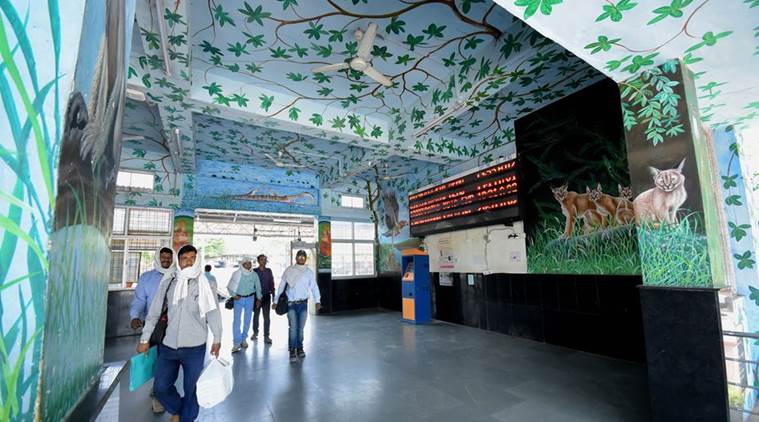 The paintings are a unique mix of the Kota-Bundi style and art from Sawai Madhopur. (Express Photo/Rohit Jain Paras)
The paintings are a unique mix of the Kota-Bundi style and art from Sawai Madhopur. (Express Photo/Rohit Jain Paras)
Kota, Rajasthan
The station
Set up in the early 1950s, the station sees around 46,000 passengers daily.
The art
The paintings, done between 2015 and 2017, are a unique mix of the Kota-Bundi style of painting and art from Sawai Madhopur in Rajasthan. On the station walls are images of the royal hunting party of former Marwar ruler Umed Singh and wildlife from Sawai Madhopur, the district that’s home to Ranthambore National Park.
“We thought the paintings should reflect the culture of the state and Hadoti region (of which Kota is a part) in particular. We selected the tiger as a theme and used the Bundi school of painting since the Mukundara tiger reserve is situated in this region,” says Ravikumar Surpur, former district collector of Kota, during whose tenure the project was taken up. Surpur is now the district collector of Jodhpur.
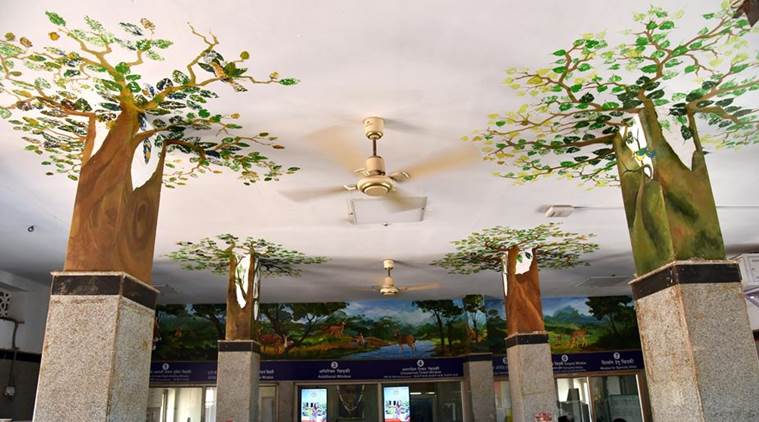 The Central Railway Sectional Commercial Inspector, Chandrapur, K K Sen, says the beautification project for the stations cost about Rs 1 crore. (Express Photo/Vivek Deshpande)
The Central Railway Sectional Commercial Inspector, Chandrapur, K K Sen, says the beautification project for the stations cost about Rs 1 crore. (Express Photo/Vivek Deshpande)
The artists
“The Kota-Bundi style of art is known for its bright colours and anecdotes from the history of the region. It took us several months to complete each painting,” says 60-year-old Sheikh Mohammed Lukman, a fifth-generation artist of the Kota-Bundi style, whose ancestors are said to have worked at the royal court. “Some of the paintings have my mobile number. Every couple of days I get calls from people who see the paintings and tell me that they like the work,” says Lukman.
He says though the Kota-Bundi style of painting was once very popular, the younger generation is not keen on learning it as it involves a lot of work and brings in little money. Lukman and fellow artists own shops in Kota, where they sell miniature paintings, mainly to tourists.
Narayan Singh, who was part of the team, says they would take the morning train from Sawai Madhopur to Kota every day for the work, and take the evening train back home.
The project
Officials say the art work at Kota, part of an initiative to beautify stations in the divisional headquarters, was done at a cost of Rs 25 lakh. “The funds were mobilised by the district collector through the Urban Improvement Trust, Kota. The CM started an aggressive tourism campaign and directed the collectors to beautify railway stations of Rajasthan, especially in the divisional headquarters,” says Surpur.
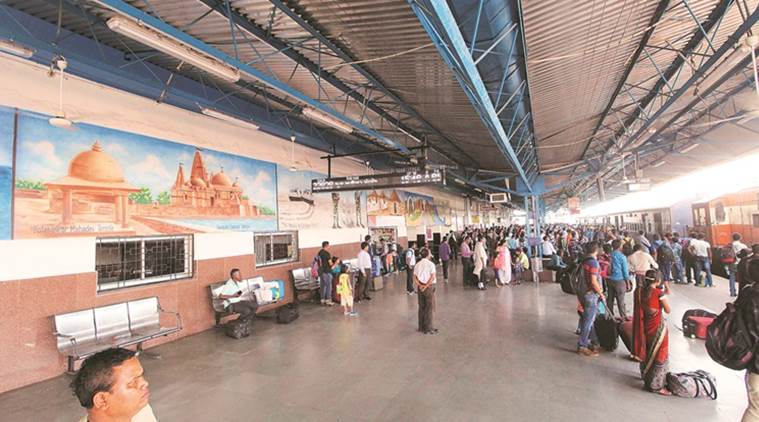 On the station wall are images from some of the most famous attractions of Kutch. (Express Photo/Javed Raja)
On the station wall are images from some of the most famous attractions of Kutch. (Express Photo/Javed Raja)
Gandhidham, Gujarat
The station
Located near Kandla, Mundra and Tuna ports, Gandhidham railway station, part of the Ahmedabad division of Western Railways, was inaugurated by then railway minister Lal Bahadur Shastri in 1955. Over last year, the station has undergone a comprehensive facelift, with silver-blue aluminium panels on the facade. “On an average, 10 passenger trains stop at Gandhidham every day and an estimated 10,000 passengers board and de-board trains here. But freight loading is our biggest business, with an average of 30 rakes — 1,400 wagons — loaded from here every day,” says Adish Pathania, Gandhidham area railway manager.
The art
The concourse hall of the railway station has 20 images from some of the most famous attractions of Kutch district. On the wall are giant paintings of flamingos and wild asses from the Wild Ass Sanctuary of the Little Rann of Kutch. There are also paintings of the Harappan site at Dholavira and the famous White Desert, both in Kutch. However, on a Tuesday afternoon, around 60 railway employees sat on a hunger strike facing the wall with the paintings. They were protesting against a new pension scheme and alleging “privatisation of the Railways”.
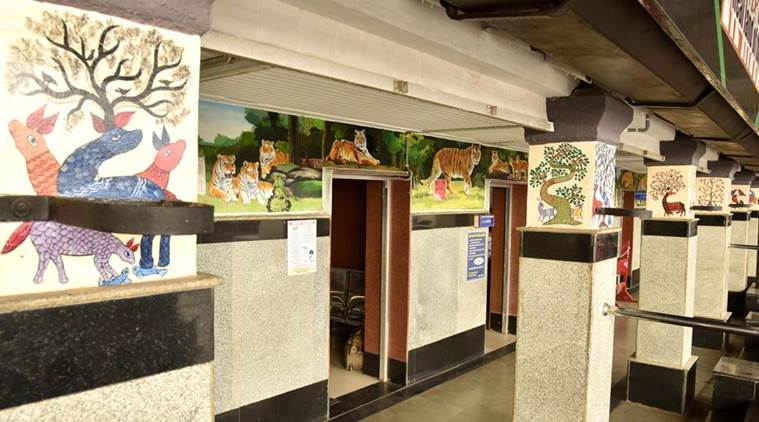 The beautification project began when Suresh Prabhu was Railways Minister. (Express Photo/Vivek Deshpande)
The beautification project began when Suresh Prabhu was Railways Minister. (Express Photo/Vivek Deshpande)
The artists
Ahmedabad-based painters Vimal Patel, Kalpesh Shah and Hansraj Sagathiya, who own a studio in Ahmedabad, were chosen to do the wall art at Gandhidham. “When the railway officers approached us, we proposed to bring Kutch alive on the walls of the railway station. The officers chose the subjects and we did the best we could,” says Patel, 39, who is from Bavla in Ahmedabad district and who has been associated with the Kutch Rann Utsav in the past. He says the artists used spray-guns to ensure that the paintings had “sharp finishing”.
The project
Since the project was completed in December, word of the paintings has spread to the ministry, helping Gandhidham win the award for the third best railway station. “Kutch is very rich in history and culture, we did not have to look elsewhere for themes. Besides, for those travelling to Kutch by train, Gandhidham is a gateway to the district. Apart from culture and history, we have also included paintings of wildlife, industries, coastline, tourist attractions and the border that Kutch shares with Pakistan,” says Kushagra Mittal, then Gandhidham area railway manager, who oversaw the beautification exercise.
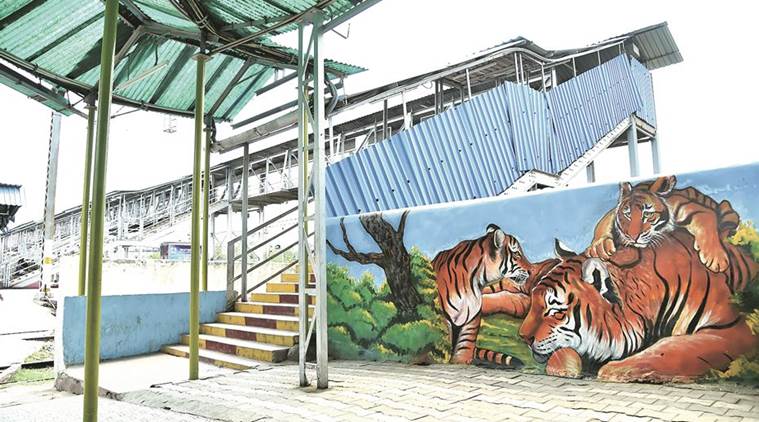 Wildlife is a prominent theme at Chandrapur station. (Express Photo/Deepak Daware)
Wildlife is a prominent theme at Chandrapur station. (Express Photo/Deepak Daware)
Secunderabad, Telangana
The station
Built in 1874 by the Nizam of Hyderabad, the station was taken over by the Indian Railways in 1951. At least 230 long-distance and suburban trains arrive or depart from the 10 platforms at Secunderabad, which won the third prize in the beautification project.
The art
The bright red of Telangana’s Cheriyal scroll paintings can be seen at half a dozen places at the station, including the sprawling waiting hall that has a 50-ft-long mural. Traditionally done on a canvas of khadi, the art is characterised by panels displaying scenes from everyday life — Telangana’s famous Bathukamma festival, rural wedding rituals and the local Gangireddulu bulls — set against a bright red background.
The artists
Last Novermber, Nagilla Ganesh and his team of eight artists from Cheriyal, a village in Telangana’s Siddipet district where fewer than 30 families keep this art form alive, took a bus to Hyderabad, 90 km away, to work at Secunderabad and Kacheguda, two of the three stations in Hyderabad.
It was Ganesh who got a call from railway officials asking if he would be interested in the project. “I immediately agreed. Everyone who goes to the railway station will now know about Cheriyal art,” says Ganesh, hoping the project will do something to revive the art.
“Many decades ago, our ancestors used to paint entire episodes of the Ramayana on scrolls, which they would take from one village to another for burra kadha (an oral storytelling tradition in rural Telangana and Andhra Pradesh for which the Cheriyal paintings would serve as a prop). It was cinema before cinema came in. But these days, youngsters in our village want to get into jobs,” says Ganesh, working on a wall at the AC lounge of the Kacheguda station.
On red being the dominant colour, Ganesh says, “Our ancestors have always used red as the base colour… It has been that way for nearly 500 years, probably because red is easy to make. First, we paint the red background and then use other colours to tell the story,’’ says Ganesh, adding that for “big paintings” like the ones at Secunderabad, they used acrylic colours and painting brushes. “For smaller ones, we use natural colours,’’ he says.
The project
“We decided to get artists from Cheriyal because this centuries-old art form is languishing, and we thought we should do something to revive it,’’ says South Central Railways General Manager Vinod Kumar Yadav.
Dhanallakota Venkataramana, who is part of Ganesh’s team, says they stayed in the railway quarters for the two months that they worked at Secunderabad station. “We started working at the end of November 2017 at Secunderabad. We did our first painting on Platform 3,’’ he says.
For Secunderabad and Kacheguda, the team has been paid nearly Rs 5 lakh. “More than the money, we are happy that people will know about our art,’’ says Ganesh.
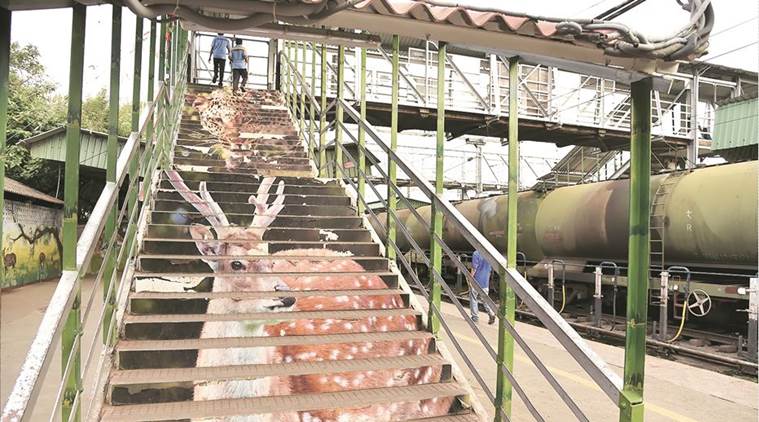 Wildlife is a prominent theme at Ballarshah station. (Express Photo/Deepak Daware)
Wildlife is a prominent theme at Ballarshah station. (Express Photo/Deepak Daware)
Chandrapur & Ballarshah, Maharashtra
The stations
Ballarshah and Chandrapur, separated by 20 km, are part of the Central Railway zone on the Grand Trunk route. While Ballarshah is a busy junction that sees about 5,000 passengers daily, only a limited number of express and passenger trains stop in Chandrapur, which sees a footfall of about 3,000.
The art
With Tadoba-Andhari Tiger Reserve barely 25 km from Chandrapur and about 40 km from Ballarshah, wildlife is a prominent theme of the art at the two stations.
At Ballarshah, a 160-sq-foot tiger mural made of fiber glass and painted golden stands at the entrance. The staircase of the foot over bridge has paintings of chitals and leopards. Near the water kiosk are paintings of tigers at watering holes.
The station facade at Chandrapur is a mosaic mural made of broken pieces of coloured tiles, besides vinyl paintings displaying Chandrapur’s wildlife and habitat.
There is a lot that catches the attention of passengers — the ceiling and pillars of the booking office have scenes depicting Chandrapur’s tribal life as well as its wildlife. A life-size sculpture of a tiger stands watching over passengers as they scramble towards the trains that make a halt here. Nearby, a group of chitals graze in a garden. On the platform, a tiger cutout is perched atop the stone plaque that announces the name of the station. There are more paintings that adorn the walls and ceilings of almost every room, including the waiting hall for passengers and the station manager’s chamber.
 Public art plays an important role in “improving the image of a railway”. (Express Photo/Sreenivas Janyala)
Public art plays an important role in “improving the image of a railway”. (Express Photo/Sreenivas Janyala)
The artists
A team of about 60 students and 10 teachers from Nagpur’s Chitrakala Mahavidyalaya were part of the project that began in June last year. “When we were thinking of a theme, we thought there was nothing more appropriate than tourism, the mainstay of Chandrapur’s economy,” says Vinod Mankar, a lecturer from Chitrakala Mahavidyalaya who led the team of artists.
“It was a pleasant surprise when both the stations were declared the most beautiful in the country,” he says.
The project
The Central Railway Sectional Commercial Inspector, Chandrapur, K K Sen, says the beautification project for the stations cost about Rs 1 crore.
“One of our Chief Minister’s Rural Development Fellows, Apurva Kirke, first come up with the idea that we could develop the Chandrapur railway station on the lines of the Sawai Madhopur station in Rajasthan,” says Chandrapur Collector Ashutosh Salil.
DRM, CR, Nagpur, Somesh Kumar admits that the challenge is to maintain the beauty of this art work. “Considering so many people visit the station, it’s difficult to keep a check all the time.”
His fear isn’t without basis. Some of the protective railings around the sculptures have vanished, the vinyl paintings have started peeling off at certain spots and the golden tiger sculpture at the entrance of Ballarshah station has pan stains at the base.
“We have done our job. Now it is the responsibility of the Railways,” says Mankar.
Apr 18: Latest News
- 01
- 02
- 03
- 04
- 05















